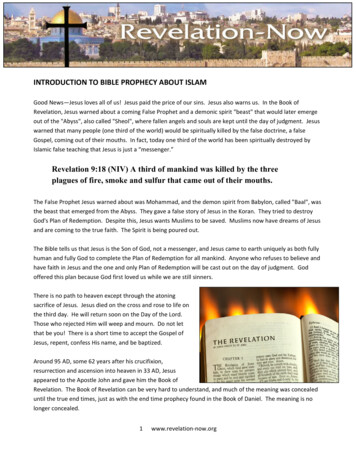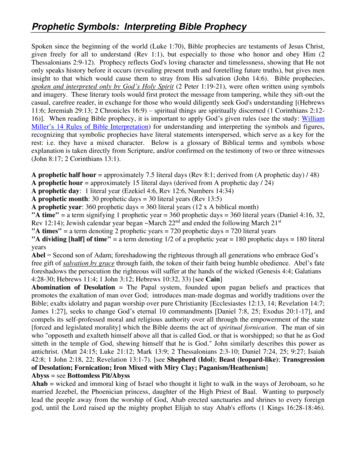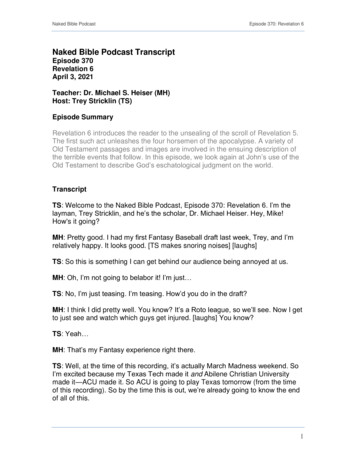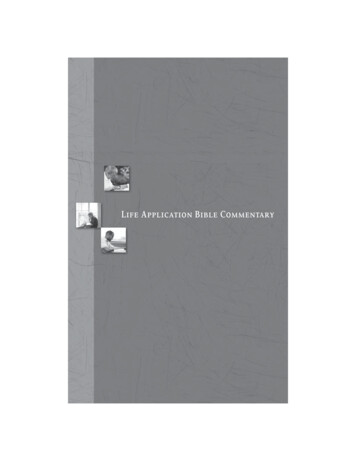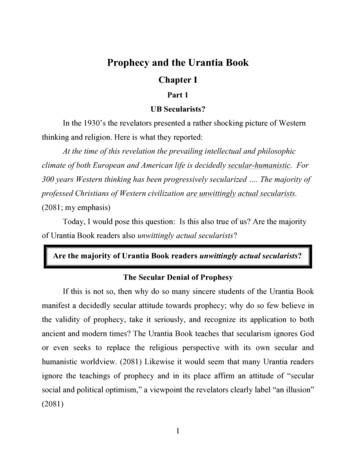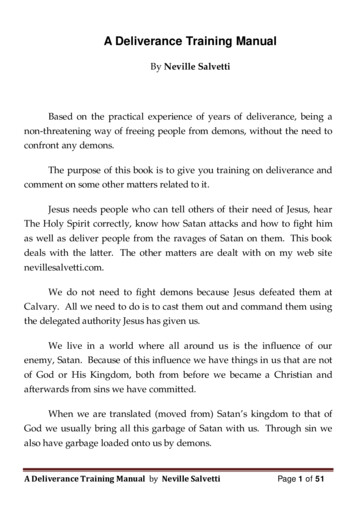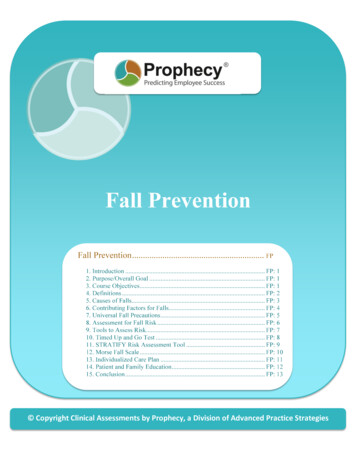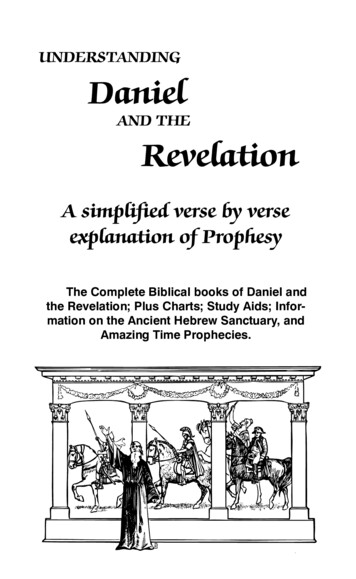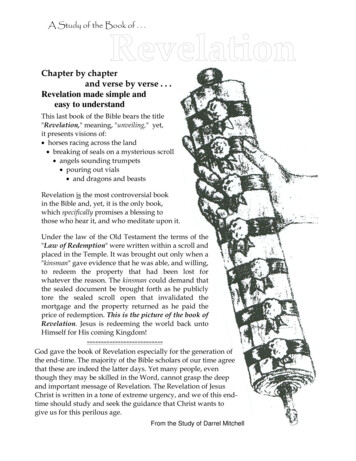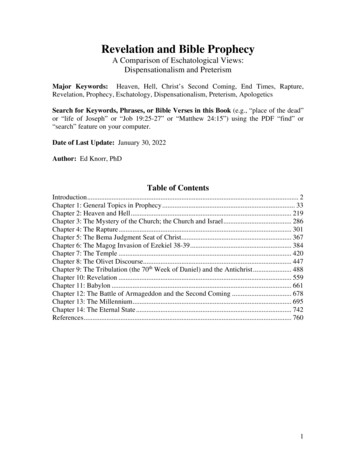
Transcription
Revelation and Bible ProphecyA Comparison of Eschatological Views:Dispensationalism and PreterismMajor Keywords: Heaven, Hell, Christ’s Second Coming, End Times, Rapture,Revelation, Prophecy, Eschatology, Dispensationalism, Preterism, ApologeticsSearch for Keywords, Phrases, or Bible Verses in this Book (e.g., “place of the dead”or “life of Joseph” or “Job 19:25-27” or “Matthew 24:15”) using the PDF “find” or“search” feature on your computer.Date of Last Update: January 30, 2022Author: Ed Knorr, PhDTable of ContentsIntroduction . 2Chapter 1: General Topics in Prophecy . 33Chapter 2: Heaven and Hell . 219Chapter 3: The Mystery of the Church; the Church and Israel . 286Chapter 4: The Rapture . 301Chapter 5: The Bema Judgment Seat of Christ . 367Chapter 6: The Magog Invasion of Ezekiel 38-39 . 384Chapter 7: The Temple . 420Chapter 8: The Olivet Discourse. 447Chapter 9: The Tribulation (the 70th Week of Daniel) and the Antichrist . 488Chapter 10: Revelation . 559Chapter 11: Babylon . 661Chapter 12: The Battle of Armageddon and the Second Coming . 678Chapter 13: The Millennium. 695Chapter 14: The Eternal State . 742References . 7601
IntroductionEschatology is the study of “last things” or the “end times”; but implicit with that is anew beginning: the future Millennium and the Eternal State, and both involve people andthe earth. The word “eschatology” is derived from the Greek word eschatos meaning“last”.This book is about a fascinating debate going on in evangelical Christian circlesregarding the book of Revelation and other books of the Bible that have eschatologicalthemes. We will take a big picture approach to see the purpose and goal of Bibleprophecy, but we’ll also go into detail as we explore prophetic passages from almostevery one of the 66 books of the Bible. The pieces of the prophetic puzzle will graduallysnap into place. It will be shown that saved persons of all ages past will get resurrected(real) bodies, and will forever enjoy the new heavens and new earth (Revelation 21-22)—and before that, the Millennial/Kingdom reign of Jesus Christ on earth, where the worldwill experience tremendous prosperity, peace, justice, and righteousness—with no morewar (Revelation 20, and many other Bible verses from both the Old Testament and theNew Testament). If you’re interested, keep reading! God has a personal interest in you.In my opinion, the eschatological model that is the most consistent with the Bible is thedispensationalist (futurist) one. This view states that most of the events described in thebook of Revelation are in the future. It interprets Scripture literally, wherever possible.Furthermore, many future events in the Old Testament including passages from the booksof Daniel, Zechariah, Isaiah, Ezekiel, etc. line up with key passages in the book ofRevelation. In fact, from Genesis to Revelation, the books of the Bible fit togetherwonderfully to provide a complete panorama of human history, including God’s futureplans for mankind.An opposing viewpoint that has gained some popularity is the partial preterist position.The word “preterist” in Latin means “past”. Preterists believe that most, or all, of theevents in the book of Revelation have already taken place, with most preterists applyingthe fulfillment mainly to 65-70 AD (with 70 AD being the fall of Jerusalem and thedestruction of the Temple); however, a second camp within preterism views propheticfulfillments in both the fall of Jerusalem in 70 AD and the fall of Rome in the 5th century[Pate, 1998]. The preterist viewpoint implies that many key prophecies need to beunderstood symbolically rather than literally—because many prophecies are written inapocalyptic language (e.g., a genre that makes use of hyperbole and symbolism).This book will give the best arguments for both preterism and dispensationalism. Ibelieve that the evidence greatly favors the dispensationalist position. This view bestharmonizes the Scriptures, facts, and doctrines. It is supported by archeological andhistorical evidence confirming past fulfillments of prophecy; consequently, we havestrong reasons to believe that unfulfilled prophecy will also be fulfilled. Just as the firstcoming of Jesus Christ the Messiah (i.e., the Anointed One, the Son of God) was literal,so will be the Second Coming.2
This book addresses questions about the Bible such as: Is the book of Revelation to betaken literally? Is Revelation mostly historical—or is it mostly about the future? Is theAntichrist mentioned in 1 John 2:18 a real human being who will appear on the worldstage prior to the Second Coming of Jesus Christ? Will there be a cashless society? Willthere be a pretribulational rapture? Is the “70th Week of Daniel” that was prophesiedcirca 540 BC a literal 7-year Tribulation period immediately preceding the return of JesusChrist? Could this happen in our lifetime? On the doctrine of imminence (Latin: “anymoment”): could Christ rapture (remove) and translate (to glorified bodies) the Church atany time? What does an end times timeline or Revelation timeline look like? Is aEuropean superpower part of a revived Roman Empire described in the book of Daniel?Is the Antichrist the world’s final Gentile leader? Will there be a literal, 1,000-yearMillennium, when Jesus Christ physically rules and reigns on Earth, and the Earth isgreatly transformed? Is Satan imprisoned during the Millennium, and then released at theend of the 1,000 years prior to his final attack on Jerusalem? Is hell a real place? IsHeaven a real place? Will we have real bodies upon resurrection? What happens afterwe die?The word “Revelation” comes from the Greek word meaning “to reveal”. Prophecy isnot written to scare us; but, rather, to prepare us [Hindson, 2012b]. In fact, the book ofRevelation—and the rest of the Bible—is written with the hope that as many people aspossible will accept Jesus Christ as their Lord and Savior. Jesus paid the penalty for oursins, on the cross, and He wants to give everlasting life (“Heaven”) to those of us whobelieve in Him. It does not matter whether you have passed away by the time He returns.We know from Scripture that God will raise the dead, and that we will have physical(“real”) bodies upon resurrection. This, and much more, will be explained in this book.Be sure that you make a commitment to Jesus Christ by asking Him to forgive your sinsand come into your life. Don’t put off the most important decision in your life, becauseyou may not make it to tomorrow. The Bible says, “ now is the day of salvation” (2Corinthians 6:2), and “Believe in the Lord Jesus Christ and you will be saved” (Acts16:31).A summary of the major definitions used in this book is available below in the sectiontitled “The Four Major Views of Revelation”. Next, as a preview, the four major viewsor models of eschatology related to timeframes are presented and summarized in theorder: (1) future (futurism, and this is where dispensationalism falls), (2) past (preterism),(3) present (historicism), and (4) timeless (idealism):1. Futurist (of which the most popular position is that of dispensationalist)—Mostof the events of Revelation are in the future, including these literal events:Rapture, Tribulation, rule of Antichrist, Battle of Armageddon, Second Coming,and Millennium. Furthermore, the Jewish people will play a major role in EndTimes events; God has a plan for them.2. Preterist—Most of the events of Revelation are in the past, with most fulfillmentshaving occurred by 70 AD. The Millennium is not literal, but instead the3
“Millennium” describes the success of Christianity over the centuries, eventuallybringing in a utopia [Watson, 2015].3. Historicist—Most of the events of Revelation have been progressing throughouthistory. The 2,300 days mentioned in Daniel, and the 1,260 days mentioned inRevelation are years, not days. There is no Rapture in historicism; however,Armageddon and the Second Coming are still to come. Historicists believe thatmost of the events documented in Revelation—including the seal, trumpet, andbowl judgments—are symbolic descriptions of historical events from Churchhistory over the past 2,000 years, with most of the events—not necessarily all—already fulfilled [Rose, 2013; Ice, 2021c]. It is thought that the successive Popesare the Antichrist. Date setting has also been a part of historicism.Historicism was the most common view from the Reformation to the mid-1800s;but, historicists view the Olivet Discourse from a preterist perspective and it isseparate from the “Tribulation” described in Revelation [Ice & Gentry, 1999].Historicists try to find events in church history that might line up with Revelation.Thus, the “tribulation” actually falls into the church age, which is a differenttimeframe than what dispensationalism believes. For example, Steve Greggsummarizes: “The historicist view has seen the final overthrow of the papacydepicted in these final judgments [in the book of Revelation]. The language issymbolic, referring to the French Revolution and subsequent events in Europeanhistory—as well as some yet future—which bring the papal power to a completeend.” [Gregg, 2013, p. 457] In his book, Gregg comments that Martin Luther wasone of the first to view Revelation Chapters 4-22 as a survey of church history.The Mormons, Jehovah’s Witnesses, and Seventh-Day Adventists hold tohistoricism [Ice, 2021c].4. Idealist—Revelation is largely symbolic (i.e., ideas and concepts), and representsthe timeless battle between good and evil. The events of Revelation are meant tobe taken symbolically, not literally, and therefore it makes no sense to infer theirtiming. Babylon, for example, could apply to literal Babylon, circa 600 BC, or itcould refer to Rome or to cities in the US and elsewhere.This book is primarily a summary and contrast of the two most popular positions inBiblical prophecy: dispensationalism and (partial) preterism. We will demonstrate thatthe position that most consistently fits Scripture is dispensationalism. Elements of theother positions may also be present, but when they are, it is usually as a secondary, ratherthan as a primary, application. In other words, certain events in Scripture may have: (a)both a near-term and a far-term fulfillment, (b) both a literal and a symbolic meaning, or(c) both a current and a historical (e.g., Old Testament) reference. As a general caseconcerning End Times prophecies, we believe that the primary meaning or application ofsuch a prophecy is literally an event looking forward to the physical Second Coming ofChrist, rather than simply a symbolic or vague historical reference that may be clouded inapocalyptic language. The Bible is rich with repeated examples, analogies, and types4
(e.g., Joseph as a type or pattern of Christ). A Biblical truth might be played outnumerous times with different circumstances and personalities, so that we understand theunderlying message—not to mention gain a greater appreciation for the depth ofScripture. We have no doubt that some secondary applications exist, but we don’tbelieve that they are the primary or only interpretation. The rest of the book will explain,in detail, what we mean. We encourage the reader to carefully consider the evidence.Let us begin by defining dispensationalism:Dispensationalism—A system of theology that interprets Scripture literally and from theperspective of God’s interaction with humanity through successive ages. This view ofbiblical history maintains one plan of salvation in which God reveals Himself to man anddeals with humanity in different ways in each successive period of their relationship oreconomy (dispensation) of time. [LaHaye, et al., 2001].Dispensationalists believe that history is broken into eras or dispensations (Greek:oikonomia, meaning “administration” or “stewardship”):1.2.3.4.Innocence (from Creation to the Fall of Adam & Eve, Genesis 1:1 to 3:7)Conscience (from the Fall of Adam & Eve to Noah’s Flood, Genesis 3:8 to 8:22)Human Government (from Noah’s Flood to Abraham, Genesis 9:1 to 11:32)Promise or Patriarchal Rule (from Abraham to Moses, Genesis 12:1 to Exodus19:35)5. Law (from Moses to the Day of Pentecost, Exodus 20 to Acts 2:4)6. Grace (from the Day of Pentecost to the Rapture (or Christ’s Second Coming),Acts 2:4 to Revelation 20:3) The 7-year Tribulation prior to Christ’s Second Coming is sometimesconsidered a separate dispensation. This is the 70th Week of Daniel,which was put on hold, when Christ was rejected, circa 30 AD.7. Kingdom (from the Second Coming to the End of the Millennium, Revelation20:4-6)Dispensation (7) is followed by the new heavens and new earth (Revelation 20:622:21)—for all eternity.The word [dispensational] means “administration” or “stewardship” .Dispensationalism teaches that there are successive dispensations throughout history andeach one involves a test or responsibility, which man fails, followed by God’s judgment.Thus, God’s grace through Jesus Christ becomes the only basis of hope for mankind.The present dispensation is known as the “age of grace” or the “church age.” Theprevious dispensation was called law or Israel. There are two peoples of God, Israel andthe church. However, God’s plan for Israel is not yet finished, and He will return to dealwith them during the seven-year tribulation and the thousand-year millennium.Dispensationalism is characterized by: (1) a consistent (from Genesis to Revelation)literal interpretation of the Bible, (2) a distinction between Israel and the church, (3) theglorification of God as His main purpose for the world. Dispensationalism is a theologydeduced from the Bible that emphasizes the glory and grace of God.” [Ice, 2011a]5
A dispensation can be viewed as a time of probation that has a distinct beginning and end[Kilpatrick, 2017a].In this book, the terms Law, Torah, and Pentateuch (meaning “five scrolls”) refer to thefirst 5 books of the Bible: Genesis, Exodus, Leviticus, Numbers, and Deuteronomy. Allwere inspired by God, and were written almost totally by Moses around 1450 BC.Classical dispensationalists are: (a) pretribulational, meaning that they expect Christ torapture (or translate) them to Heaven prior to a 7-year period of chaotic time on Earthcalled the Tribulation—a time of God’s wrath on Earth coinciding with the temporaryreign of Antichrist; and (b) premillennial, meaning that they expect Christ to physicallyreturn to Earth (at Armageddon), and then establish a 1,000-year earthly kingdom underHis reign—a time of great peace and prosperity. Thus, classical dispensationalists holdto two stages in the coming of Christ: a pretribulational rapture, and the Second Comingof Jesus Christ seven or more years later. (c) They apply a consistent distinction betweenIsrael and the Church throughout history. God made some unconditional promises toIsrael, and those still apply today. God has separate programs for Israel and the church.The doctrine of the pretribulational Rapture comes out of this. In other words, the churchwon’t be here during the Tribulation. Furthermore, (d) classical dispensationalists use aconsistent, literal interpretation of prophecy.There is a variant of dispensationalism called progressive dispensationalism [Price,2018]. Although it is mostly pretribulational and premillennial, it does not draw adistinction between Israel and the Church. In other words, it spiritualizes the Church,claiming that the Church has replaced Old Testament Israel as the “true Israel”.Progressive dispensationalists are looking for a future Millennial Kingdom, but believewe are already in the first phase of this kingdom. Furthermore, they take propheticpassages more symbolically than literally. For example, progressive dispensationalistsbelieve that Christ is ruling on David’s Throne in Heaven right now; whereas, classicaldispensationalists believe that Christ’s reign on David’s Throne will take place on Earthduring the Millennium (i.e., Christ will literally rule during the Millennium).In this book, we will use the term dispensationalist as a synonym for classicaldispensationalist.Hank Hanegraaff (not a dispensationalist) writes:Dispensationalism is distinctive for its teaching that the Church will be “raptured” fromthe earth in the first phase of Christ’s second coming so that God can return to his workwith national Israel, which was put on hold after Israel’s rejection of Messiah. God’srenewed working with Israel is thought by many dispensationalists to include a sevenyear period of tribulation under the Antichrist in which two-thirds of the Jewish peoplewill be killed, followed by the second phase of Christ’s second coming in which Christand the martyred “tribulation saints” will rule for a thousand years . [Hanegraaff, 2007,p. 272]The term preterism is derived from a Latin word for “past”. Preterism claims that at leastsome—if not all—of the prophecies in the book of Revelation were fulfilled during and6
before 70 AD. The “last days” started when Jesus was alive on earth, and ended in 70AD with the fall of Jerusalem [Newton, 2012]. The fall ended 3½ years of the “GreatTribulation”. 70 AD was the end of the “old covenant” era [Newton, 2012]. Preterismdoes not believe in a pretribulational Rapture. “The church lives in the kingdom now.The kingdom of God will be victorious in time and space in the earth. There is no needfor a new temple in Jerusalem; neither will animal sacrifices ever be accepted by God.”[Newton, 2012, p. 22]Historically, the label preterism referred to what we would call partial preterism or mildpreterism today [Hitchcock & Ice, 2007]. In some circles, partial preterism is referred toas postmillennialism, dominion theology, or victorious eschatology [Newton, 2012].An essential component of preterism is the acceptance of an early writing of Revelation,that is, before 70 AD. Dispensationalism, on the other hand, assumes that Revelation waswritten around 90-95 AD, with 95 AD being commonly accepted [Hitchcock, 1995]. Thefirst preterists were believed to be Roman Catholics, and the first Protestant preterist wasbelieved to be Hugo Grotius circa 1640 [Watson, 2017].I will try to update this book when corrections or revisions are in order. I believe thatcertain aspects of both of dispensationalism and preterism are correct; however, in myopinion, the dispensationalist position fits much better with the Scriptures (i.e., the booksof the Bible). Prophecy sometimes has a double fulfillment: a secondary fulfillment anda primary fulfillment—and usually, but not always, the secondary one comes first,especially if it’s symbolic. Thus, some of the preterist, idealist, or historicist arguments,especially the symbolic aspects, may have value.Because of the Bible’s track record regarding the literal fulfillment of prophecy, we cantrust the Bible. Mark Hitchcock writes:Even the most skeptical person can put the Bible to the test by noting the literal, precisefulfillment of past prophecies. . Think about it: If hundreds of biblical prophecies havebeen meticulously and accurately fulfilled, then it stands to reason that what the Bible hasto say about other things—such as the nature and character of God, creation, the nature ofman, salvation, and the existence of heaven and hell—are 100 percent accurate as well.[Hitchcock, 2010, pp. 8-9].The book of Revelation is highly prophetic, and is relevant to every age—especially totoday! Where I differ from preterists is that I believe that much of Revelation is stillfuture, and that much of Revelation is to be taken literally; however, the metaphors andsymbolic language are also indicative of various past events. Since the prophecies ofChrist’s first coming were literally fulfilled, it stands to reason that the prophecies of HisSecond Coming will be literally fulfilled. Furthermore, often the past event is aforeshadowing of a much greater fulfillment in the future. God is a genius: I believethese “complications” (e.g., evidence suggestive of both dispensationalism and preterism;arguments for literalism and symbolism) are intentionally put there by God because Hewants us to actively study and debate prophecy, without giving everything away, and7
without having people “influence” the fulfillment of prophecy (which, these days, couldhave disastrous global consequences).Regarding the time in which we live—a time that is getting very close to the return ofChrist, Chuck Missler writes:We are being plunged into a period of time about which the Bible says more than it doesabout any other period of time in history, including the time that Jesus walked the shoresof Galilee or climbed the mountains of Judea. [Missler, 2003a]By studying various books and listening to various speakers, we learn a lot about theBible, and are strengthened with “the blessed hope” of Christ’s imminent return(Rapture). Hank Hanegraaff often says that “iron sharpens iron”, that is, we learn fromeach other: we can agree to disagree on non-essential parts of Christianity, vigorouslydebate them, but hold to the essential doctrines of Christianity. Such essential doctrinesinclude: original sin (Adam and Eve in the Garden of Eden), Noah’s Flood, God takingon human form (i.e., Jesus Christ), Christ being born of a virgin, Christ’s sinless life,Christ paying the full penalty for our sins through His death on the cross (i.e., GodHimself dying for his creation), Christ’s resurrection on the third day, the future personalappearance of Christ (“the Second Coming”), the future judgment of all people who haveever lived, the existence of Heaven and Hell, the restoration of the Earth and the rest ofcreation, etc.One may summarize the Bible as a drama in four acts—creation, fall, redemption, andrestoration:The purpose of Jesus’s coming is to put the whole world right, to renew and restore thecreation, not to escape it. It is not just to bring personal forgiveness and peace, but alsojustice and shalom to the world. God created both body and soul, and the resurrection ofJesus shows that he is going to redeem both body and soul. The work of the Spirit ofGod is not only to save souls but also to care and cultivate the face of the earth, thematerial world.It is hard to overemphasize the uniqueness of this vision. Outside of the Bible, no othermajor religious faith holds out any hope or even interest in the restoration of perfectshalom, justice, and wholeness in this material world. [Keller, 2008]There appears to be substantial evidence for an early rapture (i.e., a rapture that takesplace considerably earlier than a simultaneous event on judgment day). Although someaspects of prophecy have both a near-term and a far-term fulfillment, the majority of theprophecies found in Revelation still refer to the future.Why do Christians have different views on eschatology? Many such individuals trulylove the Lord, genuinely seek the truth, and try to put Christ first in their lives. Perhapsthe Lord has cleverly designed Scripture in the way He did to make us excited aboutprophecy, to continue studying it, to debate it, and to avoid having us “cause” Scripture tobe fulfilled in a particular way through our own actions. God knows the future, but thatdoes not mean He causes it.8
All Scripture is inspired by God (2 Timothy 3:16-17), and is inerrant in the originalmanuscripts. About 27% of the Bible is about prophecy (i.e., 8,352 verses out of 31,124verses in the whole Bible) [House & Price, 2003]. There are 1,845 references to Christ’sSecond Coming in the Old Testament, and 318 such references in the New Testament.Compare that to the 109 declarations in the Bible about His first coming [LaHaye, 2012].In the Bible, the doctrine of salvation is mentioned the most in Scripture; then, Christ’sSecond Coming; and in third place, we have the tribulation, which is mentioned in morethan 60 Scripture passages [LaHaye, 2011a; Hindson, 2021]. The Apostle Paulmentioned the Second Coming 50 times, baptism 13 times, and communion twice.The Bible was written by 40 authors, supernaturally inspired by God, over a period of1500-2100 years (Moses wrote Genesis-Deuteronomy in approximately 1400-1450 BC,and Revelation was written shortly before 100 AD; but, it’s possible that the book of Jobwas written around 2000 BC). Bible prophecy can be used to confirm that the God of theBible is the one true God, by tracking the fulfilled prophecies.The table on the following pages list the “books” of the Bible, and the approximate dateswhen these books (scrolls, parchments) were written. There are 39 books in the OldTestament, and 27 books (some of them as short as a page or two) in the New Testament.The Old Testament Scriptures are the same as those used by the Jewish people. The NewTestament means “New Covenant”; it begins with, and ends with, the story ofChristianity, that is, the life, testimony, and teachings of Jesus Christ the Messiah (alsoknown as “the Anointed One” or “Savior” or “Son of God”). Christ was the fulfillmentof what the Old Testament prophets had prophesied about, for many hundreds of years.The Jewish people largely rejected Christ, and are still looking for the (first) appearanceof the Messiah. Interestingly, it has been said that 30% of the Jews in the first centuryaccepted Christ, including some of the Pharisees [Ice, 2021d].Christ made it clear that: (a) He is the Messiah, and (b) He is coming back.The Hebrew (Jewish) Bible (also called the Tanakh) orders the Scriptures as follows: Torah – “The Law”Nevi’im – “The Prophets”Ketuviw – “The Writings”The Old Testament in the Christian Bible contains the same Scriptures, but orders themas follows: The Historical Books (17 of them)The Wisdom Books (5 of them)The Prophets (17 of them)How do we know that the Bible is the Word of God? Hank Hanegraaff uses the acronymMAPS to provide proof of the Bible’s Divine Inspiration [Hanegraaff, 2011]:9
Manuscript C-O-P-I-E-So Copyist Practices—very careful copying of manuscriptso Oral Culture—memorization was stressed, before the print ageo Papyrus & Parchment—many old documents existo Internal Evidence—within the Bibleo External Evidence—from outside the Bible (i.e., from secular history)o Science of Textual Criticism—an integrated messageArchaeologist’s S-P-A-D-Eo Steles & Stones—archaeological finds in the Middle Easto Pools & Fools—references to locations that weren’t found until recentlyo Assyrian Archaeology—major archaeological findso Dead Sea Scrolls—in 1947, a gold mine of very old documents (OldTestament books); they confirm that the previous oldest manuscripts wehad been relying on, are virtually unchanged from the Dead Sea Scrollso Epic of Gilgamesh—records of a major floodProphetic S-T-A-R-So Succession of Nationso Typological Prophecyo Abomination of Desolationo Resurrection Prophecieso Superstar ABCsScriptural L-I-G-H-T-So Literal Principleo Illumination Principleo Grammatical Principleo Historical Principleo Typology Principleo Synergy PrincipleFor example, the ancient manuscripts, of which there are many, confirm the integrity ofthe Scriptures. There are very minor differences among some of these parchments, oftenjust small copying mistakes (e.g., a spelling mistake or an omitted word, and these areonly in a small number of manuscripts rather than all of them, so that the original can beconfirmed by the majority).Archaeology continues to reveal historical, buried artifacts and even buried towns—someof which had not been confirmed by documentation external to the Bible—until recently.Thus, the historical and chronological writings of the Bible stand the test of time, and canbe relied upon.There are many fulfilled prophecies in the Bible—prophecies that could not have beenfulfilled by chance. Many such prophecies are listed throughout this book. In fact, thereare about 1,000 prophecies in the Bible, and about 500 have been literally fulfilled, so far[Hitchcock, 2019d]. This gives us confidence that the Bible is true. Of theapproximately 500 prophecies that are left to be fulfilled, we can be confident that they,too, will be literally fulfilled.10
Finally, the scriptural synergy of the Bible is amazing: it is a series of interwovenmessages that together explain God’s complete, sufficient, and saving message tomankind.11
The Books of the Bible are listed here in their order of appearance in most modern translations (e.g., [NIV, 2002]). Each book’s author(s)wrote under the inspiration of the Holy Spirit (i.e., under the direction of God); hence, the Bible is acknowledged to be“the Word of God”. The Old Testament is the same as the Hebrew Scriptures (i.e., Law, Prophets, and Writings).Old Testament (39 books)New Testament (27 books)BookBookAuthor(s)MatthewMarkLu
2 Introduction Eschatology is the study of “last things” or the “end times”; but implicit with that is a new beginning: the future Millennium and the Eternal State, and both involve people and the earth. The word “eschatology
